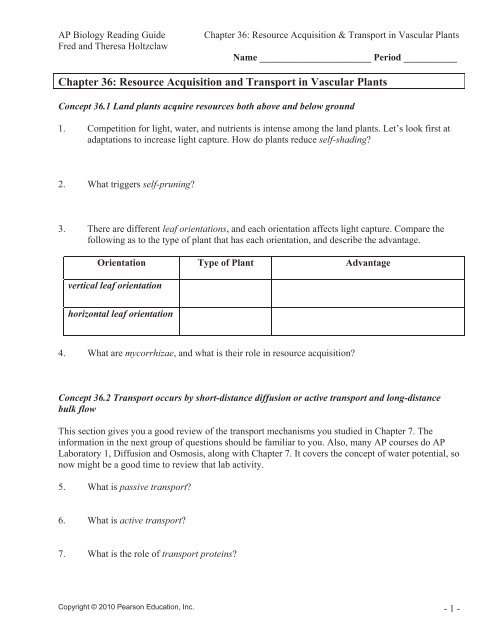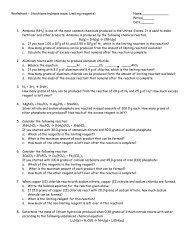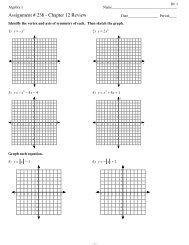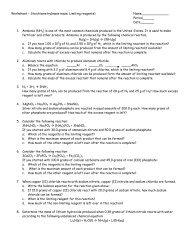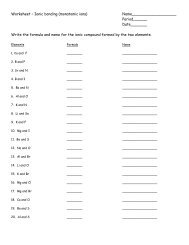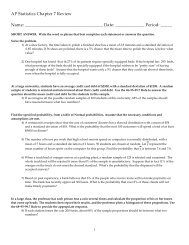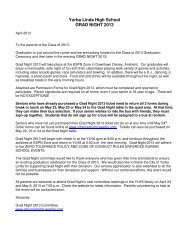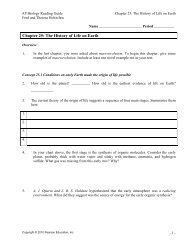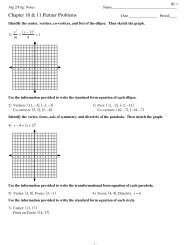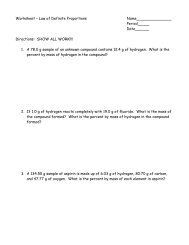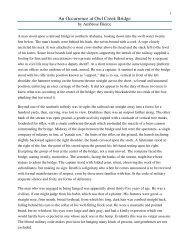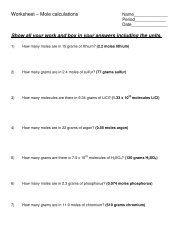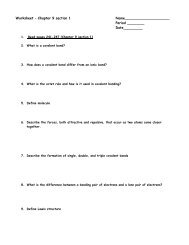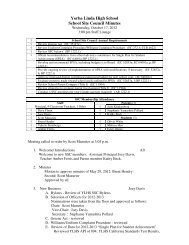Chapter 36: Resource Acquisition and Transport in Vascular Plants
Chapter 36: Resource Acquisition and Transport in Vascular Plants
Chapter 36: Resource Acquisition and Transport in Vascular Plants
- No tags were found...
You also want an ePaper? Increase the reach of your titles
YUMPU automatically turns print PDFs into web optimized ePapers that Google loves.
AP Biology Read<strong>in</strong>g GuideFred <strong>and</strong> Theresa Holtzclaw<strong>Chapter</strong> <strong>36</strong>: <strong>Resource</strong> <strong>Acquisition</strong> & <strong>Transport</strong> <strong>in</strong> <strong>Vascular</strong> <strong>Plants</strong>Name _______________________ Period ___________<strong>Chapter</strong> <strong>36</strong>: <strong>Resource</strong> <strong>Acquisition</strong> <strong>and</strong> <strong>Transport</strong> <strong>in</strong> <strong>Vascular</strong> <strong>Plants</strong>Concept <strong>36</strong>.1 L<strong>and</strong> plants acquire resources both above <strong>and</strong> below ground1. Competition for light, water, <strong>and</strong> nutrients is <strong>in</strong>tense among the l<strong>and</strong> plants. Let’s look first atadaptations to <strong>in</strong>crease light capture. How do plants reduce self-shad<strong>in</strong>g?2. What triggers self-prun<strong>in</strong>g?3. There are different leaf orientations, <strong>and</strong> each orientation affects light capture. Compare thefollow<strong>in</strong>g as to the type of plant that has each orientation, <strong>and</strong> describe the advantage.Orientation Type of Plant Advantagevertical leaf orientationhorizontal leaf orientation4. What are mycorrhizae, <strong>and</strong> what is their role <strong>in</strong> resource acquisition?Concept <strong>36</strong>.2 <strong>Transport</strong> occurs by short-distance diffusion or active transport <strong>and</strong> long-distancebulk flowThis section gives you a good review of the transport mechanisms you studied <strong>in</strong> <strong>Chapter</strong> 7. The<strong>in</strong>formation <strong>in</strong> the next group of questions should be familiar to you. Also, many AP courses do APLaboratory 1, Diffusion <strong>and</strong> Osmosis, along with <strong>Chapter</strong> 7. It covers the concept of water potential, sonow might be a good time to review that lab activity.5. What is passive transport?6. What is active transport?7. What is the role of transport prote<strong>in</strong>s?Copyright © 2010 Pearson Education, Inc. - 1 -
AP Biology Read<strong>in</strong>g GuideFred <strong>and</strong> Theresa Holtzclaw<strong>Chapter</strong> <strong>36</strong>: <strong>Resource</strong> <strong>Acquisition</strong> & <strong>Transport</strong> <strong>in</strong> <strong>Vascular</strong> <strong>Plants</strong>8. What are the most important plant cell transport prote<strong>in</strong>s? How do they work?9. What is membrane potential? How can it be established?10. Expla<strong>in</strong> cotransport.11. What is osmosis?12. Plant cells have a rigid cell wall, which adds another factor that affects osmosis: pressure.Def<strong>in</strong>e water potential.The equation for water potential is = s + p, , where is water potential, s is solute potential, <strong>and</strong> p is the pressure potential. The underst<strong>and</strong><strong>in</strong>g of this formula is an objective from Laboratory 1 <strong>in</strong> theAP Laboratory book.13. By def<strong>in</strong>ition, what is the s of pure water?14. How does add<strong>in</strong>g solutes to pure water affect water potential?15. The solute potential of a solution is therefore always ____________. (negative or positive)16. What is pressure potential? Under what conditions will it decrease?A B C DCopyright © 2010 Pearson Education, Inc. - 2 -
AP Biology Read<strong>in</strong>g GuideFred <strong>and</strong> Theresa Holtzclaw<strong>Chapter</strong> <strong>36</strong>: <strong>Resource</strong> <strong>Acquisition</strong> & <strong>Transport</strong> <strong>in</strong> <strong>Vascular</strong> <strong>Plants</strong>17. What is the water potential on the left side of tube A? Why?18. Is the water potential on the right side of tube A positive or negative?19. Expla<strong>in</strong>, <strong>in</strong> terms of water potential, why the level of the liquid is higher on the right side oftube A.20. In tube B, pressure is be<strong>in</strong>g applied on the right side. This is much like the pressure exerted bythe cell wall when a plant cell takes up water. Expla<strong>in</strong>, <strong>in</strong> terms of water potential, why thelevel of liquid is the same on both sides even though the two solutions are not isotonic to eachother.21. To summarize, water moves from regions of ________________water potential to regions of___________water potential.22. Def<strong>in</strong>e these terms:flaccidturgidplasmolysis23. In the figure below, a plant cell that has an <strong>in</strong>itial water potential of –0.7 MPa is placed <strong>in</strong>totwo different conditions. Expla<strong>in</strong>, <strong>in</strong> terms of water potential, what is happen<strong>in</strong>g <strong>in</strong> each case.a.b.Copyright © 2010 Pearson Education, Inc. - 3 -
AP Biology Read<strong>in</strong>g GuideFred <strong>and</strong> Theresa Holtzclaw<strong>Chapter</strong> <strong>36</strong>: <strong>Resource</strong> <strong>Acquisition</strong> & <strong>Transport</strong> <strong>in</strong> <strong>Vascular</strong> <strong>Plants</strong>28. What is the role of the Casparian strip?29. Write a short essay to expla<strong>in</strong> the movement of water from the soil <strong>in</strong>to the stele of the root,us<strong>in</strong>g all the terms <strong>in</strong> question 27.30. What is transpiration?31. There are two mechanisms that pull water up through the plant, from roots to leaves. Expla<strong>in</strong>root pressure.Copyright © 2010 Pearson Education, Inc. - 5 -
AP Biology Read<strong>in</strong>g GuideFred <strong>and</strong> Theresa Holtzclaw<strong>Chapter</strong> <strong>36</strong>: <strong>Resource</strong> <strong>Acquisition</strong> & <strong>Transport</strong> <strong>in</strong> <strong>Vascular</strong> <strong>Plants</strong>32. The second mechanism that pulls water up through the plant is transpiration-cohesion-tension.Refer to this sketch <strong>in</strong> your text. Note that water is mov<strong>in</strong>g from a region of high waterpotential to a region of lower water potential. The arrow on the left side of the figure shows thisgradient. Beg<strong>in</strong>n<strong>in</strong>g from where you stopped <strong>in</strong> question 29, write an essay to expla<strong>in</strong> themovement of water from the roots to the leaves. Include each of these terms <strong>in</strong> your essay, <strong>and</strong>label them on the figure: lower water potential, higher water potential, hydrogen bond<strong>in</strong>g,adhesion, cohesion, xylem tubes, <strong>and</strong> stomata.Copyright © 2010 Pearson Education, Inc. - 6 -
AP Biology Read<strong>in</strong>g GuideFred <strong>and</strong> Theresa Holtzclaw<strong>Chapter</strong> <strong>36</strong>: <strong>Resource</strong> <strong>Acquisition</strong> & <strong>Transport</strong> <strong>in</strong> <strong>Vascular</strong> <strong>Plants</strong>Concept <strong>36</strong>.4 Stomata help regulate the rate of transpiration33. Leaves generally have large surface areas <strong>and</strong> high surface-to-volume ratios. Give an advantage<strong>and</strong> disadvantage of these traits.advantagedisadvantage34. <strong>Plants</strong> lose 95% of their water through stomata! What controls the amount of water loss?35. On the sketches, label the guard cell, stomata, K + , <strong>and</strong> H 2 O. Expla<strong>in</strong> why the stoma openswhen K + accumulates <strong>in</strong> the guard cells.<strong>36</strong>. Three types of stimuli can cause guard cells to open. Name <strong>and</strong> expla<strong>in</strong> how each one works.Stimulus for Stomatal Open<strong>in</strong>g <strong>and</strong>ExplanationClos<strong>in</strong>gCopyright © 2010 Pearson Education, Inc. - 7 -
AP Biology Read<strong>in</strong>g GuideFred <strong>and</strong> Theresa Holtzclaw<strong>Chapter</strong> <strong>36</strong>: <strong>Resource</strong> <strong>Acquisition</strong> & <strong>Transport</strong> <strong>in</strong> <strong>Vascular</strong> <strong>Plants</strong>37. What plant hormone is produced <strong>in</strong> response to water deficiency?38. List four different physiological or morphological adaptations of xerophytes, <strong>and</strong> expla<strong>in</strong> howeach of them reduces water loss.Concept <strong>36</strong>.5 Sugars are transported from leaves <strong>and</strong> other sources to sites of use or storage39. What is translocation?40. What is a sugar source, <strong>and</strong> what is a sugar s<strong>in</strong>k? Give an example of each.41. What cell types transport the sugars?42. Expla<strong>in</strong> the process of pressure flow by annotat<strong>in</strong>g the figure below. Refer to your text, <strong>and</strong>divide this process <strong>in</strong>to four steps.Copyright © 2010 Pearson Education, Inc. - 8 -


